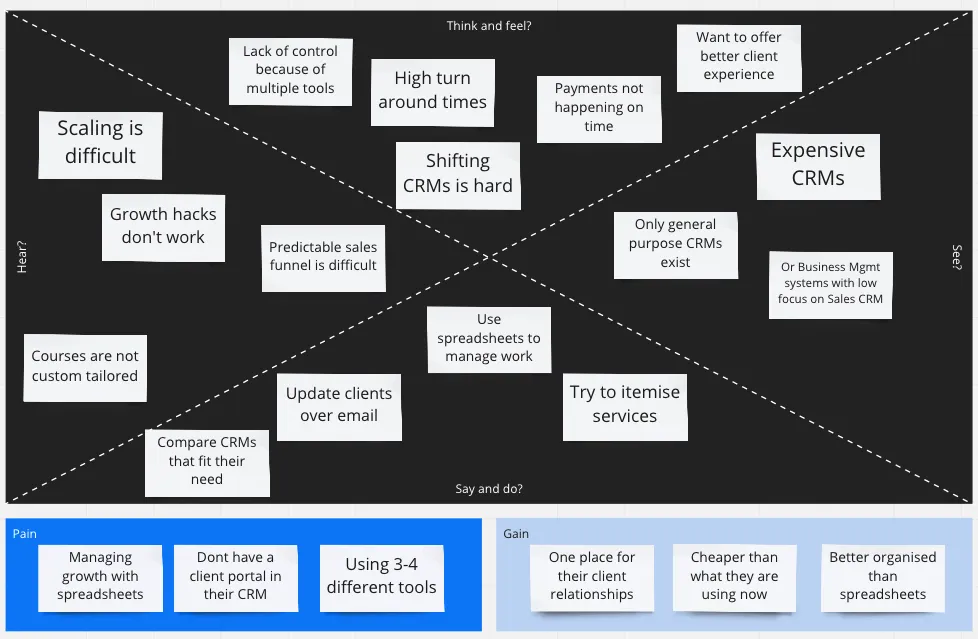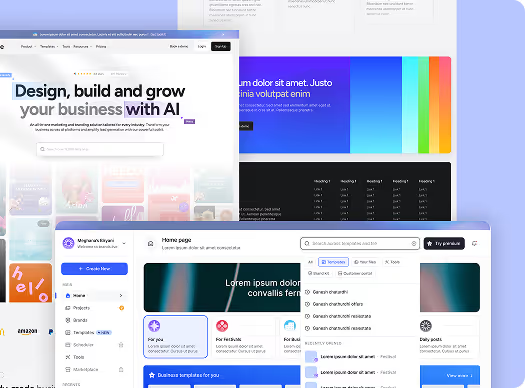Journey of founding, building, growing and exit-ing Clientjoy

The beginning
In early 2019, we were a 55 people SaaS product design and development agency that primarily catered to enterprises. We had built about 20 SaaS products and by that time we had observed the journey of a few of them going from 0 to $1M in ARR.
Completely bootstrapped and trying to grow, we had typical agency challenges. One of them was having to use 7 different platforms to engage and collaborate with our clients. We were using Pipedrive as our sales CRM, Pandadoc for sending proposals, Asana for project management, Slack for chat, freshdesk for ticketing and quickbooks for invoicing. Even after using all of these platforms, client communication happened over emails and whatsapp. More importantly, it felt like I had no control over the agency.

We were reconciling payments manually. Before every client meeting, I had to look through all our communication channels to figure out how their project was going. I did not know which was our most profitable project or which was our most valued client. The team was doing over time but still missing deliveries. Clients did not have the clarity they should have been offered while projects were going on. Typical agency stuff.
We thought we were over working and clients felt they were over paying.
The research
I started this agency in 2011. Over the years, I had become part of a lot of agency communities. Some other agency founders were also good friends. I started sharing the challenges we had with other agency founders only to realize that it was a similar situation at their place as well. These challenges were not only limited to tech agencies but also existed for digital marketing agencies, design agencies and even consulting firms. As I continued to speak to more and more agency folks, my conviction grew stronger.
[image]
Agency < – > Client relationship is broken.
Most agency founders had accepted this as a way of life. They had accepted that the only outcome of not solving this challenge is that they won’t be able to scale. And they had found happiness in staying boutique size. The size where founders attend to all clients. Where they play an irreplaceable role from sales through fulfillment and finally payment.
Here’s the empathy mapping we did:

I started reaching out to our agency partners in the US. Cold messages on Linkedin asking for advice. They were gracious with their time. Unlike before when I was speaking to my other agency friends, this time, I started doing a structured research. Open ended questions that did not lead them to give the answers that confirmed my thesis. In fact, there were some questions I asked which would lead them to deny my thesis.
After about 20 recorded one hour calls over 2 months, I presented my findings internally.
The thesis
Help Agencies build better relationships with their clients by helping them collaborate effectively across all stages of a client lifecycle - Sales, fulfillment and revenues.
Clientjoy was born.
The idea was that we’ve built over 20 SaaS products. We know how to build it. We have also observed growth experiments that our clients ran on their marketing channels. We need to figure out how to distribute it and get it in the hands of as many agency owners as possible in as little time as possible.
Here’s a snapshot of our product documentation

However, the challenges were immense:
- Why would a creative agency owner in New York trust a SaaS product no one has ever heard of?
- We would need to build a Sales CRM, an eSigning product, a client portal, an invoicing system and a payment system - all in one.
- Our customers will need to make a decision to migrate away from 4 systems to our system which could increase their risk.
- We needed to ensure that security was A grade.
- Agency owners come in various shapes and sizes. We needed to design the product such that a 65 year old independent consultant from South Africa and a 21 year old freelance graphic designer from Spain (both real customers by the way) could navigate seamlessly.
We knew we needed external capital
Raising capital for Clientjoy
Our proposal was simple. We understand the business of our customers very well given that we had been doing that exact business for half a decade in 2019. Along with that, we also knew how to build the product well because that was what we were offering to our clients at the time.
We were looking for seed capital and like most SaaS founders do, we made the mistake of reaching out to investors too early. We only had a figma prototype and were influenced by stories on Techcrunch where seed rounds seemed to happen at the idea stage. We found this to be untrue for first time founders. By only reading publications like Techcrunch, Tech in Asia and Yourstory, we thought that raising capital is easy because they only feature founders and stories where capital has been raised. There is no data available on how many start-ups try to raise and are never able to.

Couple of investor calls later, I realized that we need to have a more structured approach. Think of Clientjoy as just another financial product in an asset class. Think of raising funds as an equivalent to selling credit cards or insurance policies.
If I asked for capital I got advice. But when I asked for advice, I got capital. Building investor relationships is better than asking for capital.
Over the next 6 months, I pitched Clientjoy to over 100 angel investors and early stage VCs. Some of them through cold outreach and others through warm introductions or referrals. Ultimately, we closed a $800K round and got 12 angel investors and one VC onboard.

We closed the round in March 2020, just before COVID hit and announced it in November 2020 when the world had started to accept the new normal.
Running services and product businesses together
The fact that we were great at building SaaS products meant that we found our comfort zone in building. For 6 months after funding closure, we kept building in isolation. We were ready with our MVP (Minimum Viable Product). This version had no growth levers. Just a sum total of all the features that we thought Agencies needed.
We posted about launching on our social media accounts. I personally reached out to my network. After doing a couple of similar activities, we waited.
We waited. No-one came. As it turned out, for a successful SaaS business, ‘building a great product’ was a necessary condition but not a sufficient condition.
We started doing cold outreach and shortly realized that having a sales led motion will not make sense financially because we were a small ticket SaaS. Our ratio of customer acquisition to customer lifetime value will not work.

All of these realizations came with the most important one.
Services and product businesses are fundamentally different.
Here are a couple of differences we realized
👉 More features for less price is not a thesis that works in SaaS
As a service company founder, we are conditioned to offer more, quickly and for less - but that thought process doesn't translate well in SaaS. The graveyard is full of cheap and feature rich SaaS products.
👉 Difference between customers and clients
Clients have requirements, customers have problems. Clients make payments, customers upgrade their subscription. Clients have SPOC and customers have cohorts. The way to comprehend solutioning is entirely different in both cases.
👉 Solving different problems with scale
In case of a services business, the problems of the business (bench, cashflow, profitability, efficiency) do not evolve. They just scale and tend to have higher and higher impact as the business grows. In a SaaS firm however, the nature of problems evolve as it scales. In early stages, founders are optimizing for PMF, then, for conversion rates, then for unit economics and in later stages, for retention and AOV. The founder needs to consistently learn solutions to newer problems in SaaS vs Services.
Launch on AppSumo
AppSumo is the world largest marketplace for buying and selling SaaS products. Here's a short video they did.

Arriving at our ICP
Optimizing our funnel
Our funnel and activity board

Building trust
How do you build trust in your prospects for your SaaS? Most likely, you will need your customers to either host a lot of their data on your platform or you will need to integrate your SaaS with their existing systems.
Here are some of the badges Clientjoy earned:

Trust becomes extremely important. Especially mid-market companies and large enterprises pay a premium for a Grade-A SaaS.
👉 Amplify awareness by securing credible media mentions. Media features offer concrete evidence of third parties acknowledging your existence. It brings us closer to the center of the universe. When potential customers see the positive experience your SaaS solutions have provided to other businesses, it instills trust.
👉 Collaborating/partnering with trusted names in the industry expands your reach and reinforces credibility. For instance, by partnering with Salesforce and integrating your SaaS product with Salesforce CRM, you can tap into Salesforce’s credibility and market dominance and strengthen your position.
At Clientjoy (Acquired by Synup), we did this with Stripe and PayPal. At Momentum, we are in the process of doing this with Webflow, Intercom, Mixpanel, and Amazon Web Services (AWS)
👉 Showcase customer success stories, testimonials from experts, case studies, and industry badges prominently on your website to serve as tangible proof of your product’s reliability and success. Look up 'social proof' of google - you'll get the gist. We are trying to do this with Clutch at Momentum and you cannot miss G2 badges on Clientjoy's website 😅
Once you acquire trust, keeping it is as important. It requires an ongoing effort. Here’s how you can do it.
👉 Consistency is the key. Are you consistent in delivering your promises, addressing client concerns, and maintaining transparency in your operations? Do you often under-commit and over-deliver?
👉 Predictability reassures clients and fosters long-term relationships. Anticipating your customers' needs and proactively keeping solutions ready before they even ask builds the credibility of your product and strengthens customer relationships.










